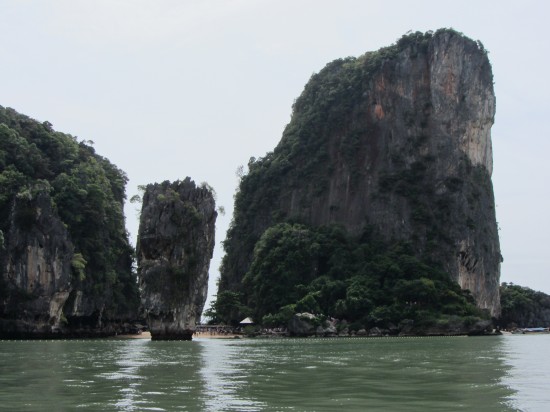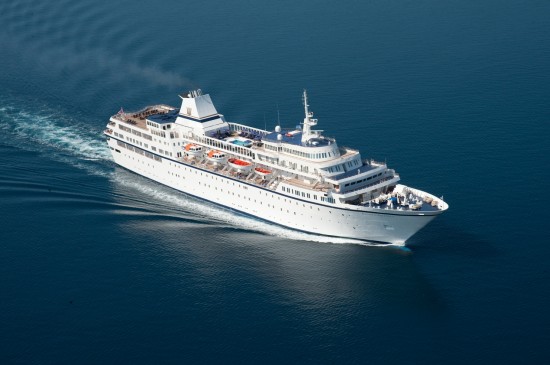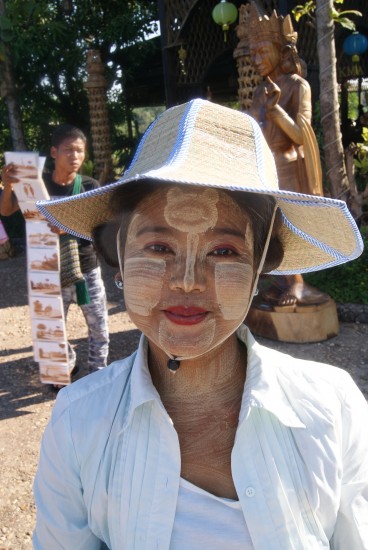The police escort brought new meaning to the term “VIP Cruising.”
The 270 passengers on our ship, Aegean Odyssey, were among the first in many years to be welcomed to Burma (also known as Myanmar), now that the military/civilian regime has finally opened itself to democratic reforms. Part of that openness is the realization that tourists bring dollars and should be encouraged to visit.
When 200 of us boarded six buses and headed north from the bustling port of Yangon (formerly known as Rangoon) to the city of Bago and its magnificent Buddhist pagodas, we were surprised to have two police officers on motorcycles, lights blazing, guide us through the heavy morning traffic. Another escort awaited us on our return to the ship. Our guide told us that the route would normally take 90 minutes. With the police leading the way, we did it in forty.
Voyages to Antiquity, the cruise operator that runs the Aegean Odyssey, normally places the cleverly converted freighter in the Mediterranean, following the routes of the ancients. With the unstable situation in Syria and Libya, management decided that South-East Asia would be an ideal fit for the ship and its target passengers – Canadians, Americans, Brits and Australians with a passion for exploration and history-oriented cruising. That’s the specialty of Voyages to Antiquity and it didn’t disappoint.
The cruise started in Singapore with a two-night stay at the luxurious Fairmont Hotel and tours of that modern, pristine city/state. Then we boarded Aegean Odyssey and headed north, with stops in Malaysia and Thailand. A highlight of Thailand was our longboat excursion among the amazing limestone islands that jut vertically from the warm waters of Phang Nga Bay. Among them is Ko Tapu, better known as James Bond Island, site of the 007 film, The Man With The Golden Gun. Close by is the small community of Ko Panyi or Sea Gypsy Village, built entirely on stilts over the water.
The high point for almost everyone on board was Burma, the former British colony that looks and feels much like it did decades ago. Yangon, the bustling commercial capital, has more intact colonial structures than any community in Asia. As we approach the city of four million, the dominant skyline feature is a series of golden pagodas thrusting skyward. The largest and most brilliant is the Shwedagon Pagoda. Now 2600 years old, it’s covered with more than 11 tons of gold and is the most sacred Buddhist pagoda in Burma.
The Aegean Odyssey docked in a downtown area next to a colourful water-taxi stand and guests were free to explore a city that’s a throwback to the days before modern communication and infrastructure. The men in their sarong-like longyi and the women, many of whom decorate their faces with a pale yellow powder called thanakha , are extremely friendly and very welcoming but the sidewalks are in miserable shape with the constant threat of stumbling into a drainage ditch. However, a short but cautious walk takes visitors to the Strand Hotel, a three-story Victorian treasure that’s hosted the likes of Somerset Maugham, George Orwell and Noel Coward. The Strand Bar, with its teak-lined walls, is a must to absorb the full flavour of this National Landmark.
There is some Internet available in Yangon but ATMs are non-existent and credit cards are virtually useless. Don’t look for a McDonalds or KFC. Leslie Cameron of Guelph, Ontario loves the fact that Burma is not overrun by either tourism or Western commercialization. “You get a raw, real feeling in the streets,” she said. “People are unaffected by tourism. The way of life here is very authentic.”
Prices for souvenirs are low and most shops, especially in the large and lively markets, welcome American dollars but will only accept them in pristine condition. Any small cut, smear or fold renders them unfit. We bought some Myanmar snacks and souvenirs at a grocery store near the ship but they wouldn’t accept American dollars, even uncirculated ones. The manager, whose English was limited, motioned us to take our 10 dollar bill and follow him up the street. We thought we might be going to a bank but instead we stopped outside a grubby residence where a large man, surrounded by two colleagues counting money, sat on a small stool. In broken English, he was introduced as the local moneychanger and our $10 translated into a fistful of Burmese currency at a good rate, more than enough for our grocery bill.
Voyages to Antiquity includes complementary tours with excellent guides at all the ports. Most guests in Burma took the police-escorted buses 80 kilometres north to Bago (others chose optional, extra-cost flights to either Bagan or Mandalay) where we had a full day marveling at the scores of Buddhist temples and shrines, particularly the Shwemawdaw. Shaped like a shining school bell with the handle piercing the sky, it’s the tallest pagoda in Burma, rising 114 metres above dozens of smaller shrines and temples. Covered with several tons of gold, it’s reputed to have some hair and teeth from The Buddha buried at its base, so it has become a major shrine for the faithful. Visitors must walk in bare feet and navigate among hundreds of maroon-clad monks with their shaved heads and determined expressions. With the nearby Reclining Buddha (at 55 metres, it’s the 2nd longest in the world) surrounded by souvenir stands, the whole area takes on a surreal, Disney aura. That feeling is enhanced with a visit to the Kya Khat Wai Monastery where we witnessed hundreds of Buddhist monks as they lined up for their noon – and last – meal of the day. Cameras flashed and visitors gawked as the pious monks marched with their rice bowls to the low tables of the dining hall where they sat on the floor to eat.
Juices and cool towels await our arrival back on the Aegean Odyssey where we can clean up and enjoy our well-equipped staterooms or relax in one of the comfortable lounges. When the ship was first converted to a cruise vessel, it had a capacity of 570. In 2008, the interior was changed again, resulting in bigger, more modern rooms and a reduced capacity, to just 380. The ship now has an excellent library, a spa and gym, teak decks, swimming pool, a performance area for the talented piano/string trio and two dining rooms, one of which extends to a rear deck. The overall food quality does not match that of the luxury cruise lines but some of the offerings are excellent and the Filipino waiters are among the best in the industry. Wine is complimentary at dinner (there is also a premium list) but the choices are limited. The Italian was excellent but the Greek was mediocre.
Voyages to Antiquity does shine consistently, however, in its main mission. The guides at every port were outstanding and most of the onboard lecturers (an important part of every cruise) gave us very informative, illustrated talks about the history and geography of the areas we were visiting. Lecturers on the big cruise ships often compete with bingo games, the casino or art auctions and attendance can be sparse. On this ship, guests want to learn about the countries we’re visiting so almost everyone attends.
Many guests are veterans of Voyages to Antiquity. Mel Shields of Toronto is typical. “This is my fifth cruise with the company,” he told us. “It has everything I want. A small ship. Few passengers. And great destinations with an archeological focus. Exactly my cup of tea.”
Image Credits
All photos by John and Sandra Nowlan. All rights reserved.
Rangoon’s Shwedagon Pagoda
Carved by the Sea – James Bond Island in Thailand
Aegean Odyssey en route to Burma
Painted faces – A sign of beauty in Burma






Please Share Your Thoughts - Leave A Comment!